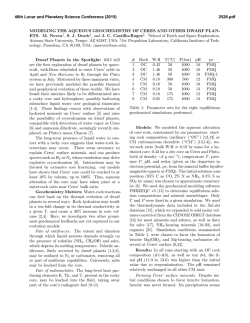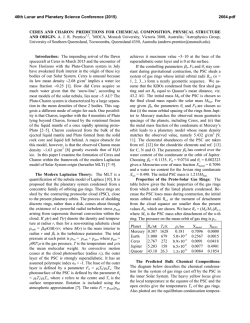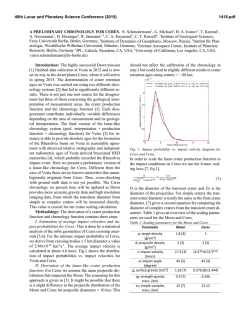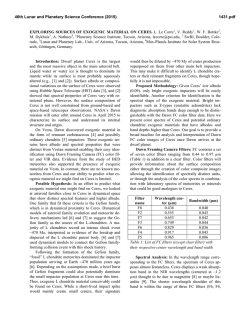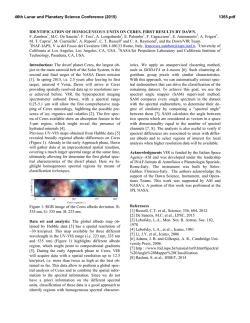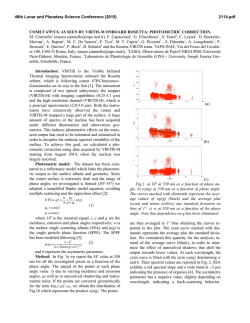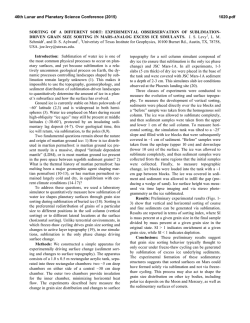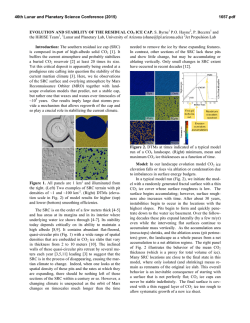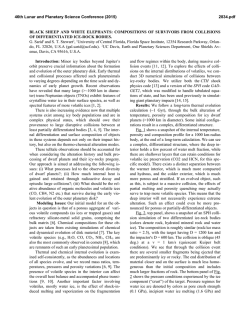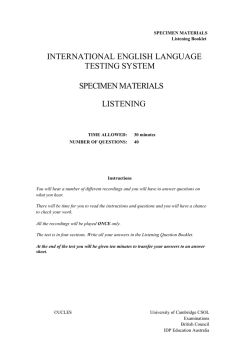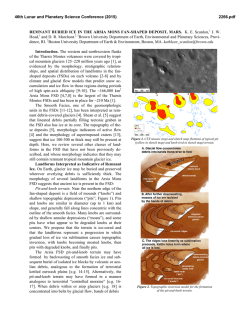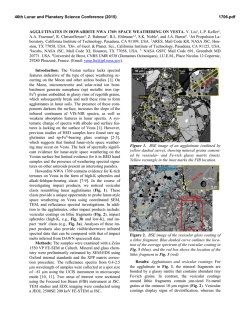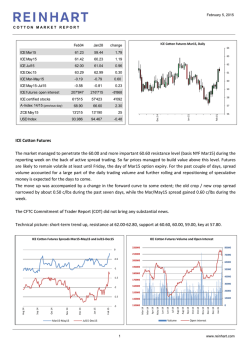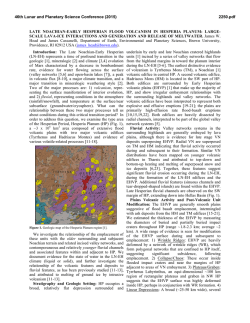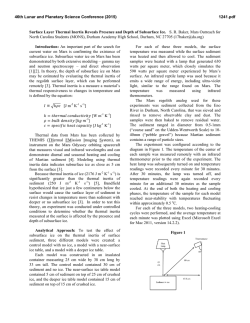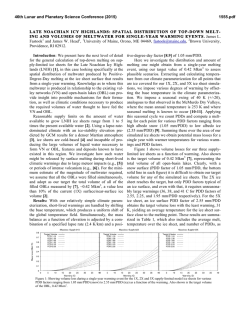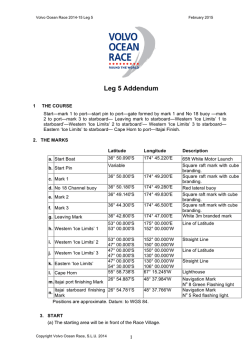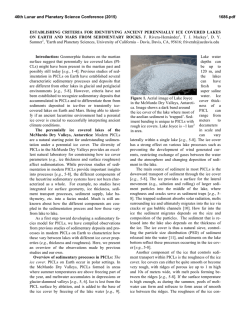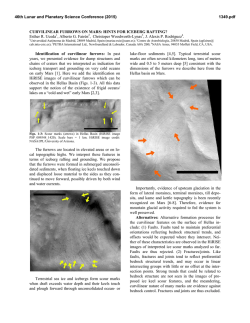
CERES: POSSIBLE RECORDS OF GIANT IMPACTS. B. A. Ivanov
46th Lunar and Planetary Science Conference (2015) 1077.pdf CERES: POSSIBLE RECORDS OF GIANT IMPACTS. B. A. Ivanov, Institute for Dynamics of Geospheres, RAS, 119334, Moscow, Russia, [email protected], [email protected]. Introduction: Recent robotic space mission to the second largest asteroid Vesta (DAWN [1]) delivered a lot of new observational data including images and gravity anomaly measurements. These data create the new database for planetological analysis including the re-iteration of previously elaborated models. A set of studies use these data to compare with numerical models to understand the specific of the impact cratering processes on Vesta and to support the data interpretation (e.g. [2, 3, 4]). The DAWN arrival to the first largest asteroid Ceres promises us the new data.. The presentation describes the specifics of the impact modeling for Ceres and displays preliminary results. The most unexpected result is the formation of impact central mound at the rocky core surface for Rheasilvia/Veneneia scale impacts on Ceres. The rocky mounds could survive even after total relaxation of the initial crater in ice. Gravity footprints of giant impact could be found with the DAWN gravity mapping of Ceres. Ceres as a target: The preliminary model of the Ceres interiors are based on the astronomical data and geochemical modeling [5, 6, 7]. Temperature at the center may be estimated in the vicinity of ~400 K with the gradual decay to the surface. The ice cover (“crust”) of ~100 km is possible [5]. The unknown additions to the ice may control the presence or absence of a thin liquid layer (“mantle”) near the surface to the silicate core. The core may be also layered due to presence of hydrated minerals in the outer rocky shell [7] – details are highly depending on the fracture state of the core and its permeability [7]. Before the better models are available we use the simplest model close in spirit to published results [5, 6, 7]: the water ice crust above a silicate core. With this simplest approximation we use available equations of state (EOS) for H2O [8] and granite (as a proxy for a rocky material with the density of 2700 kg m-3). Both EOS’es are tested previously [9, 10]. The acoustic fluidization model with parameters for the previous Rheasilvia modeling on Vesta [2] is used. We assume that impacts of projectiles 30 to 40 km in diameter were as frequent on Ceres like on Vesta, and 2 to 4 (or so) large impacts could occur during Ceres’es geologic history. Preliminary results: We model vertical impacts of rocky (same as the core material) projectiles with diameters from ~28 km to ~80 km at the ice shell ~100 km thick. The impact velocity of 4.5 km s-1 is assumed to be close to the average impact velocity for Ceres at the current position in the main belt [11]. Selected frames illustrate the impact cratering for Dproj = 32 km (Fig. 1). The final modeled time moments for the largest (Dproj=80 km) and the smallest (Dproj=20 km) is shown in Fig. 2. The central mound formation is observed for all modeled variants with Dproj > 30 km. The shock wave is not a strong one here (~15 GPa and below). However the reflection at the ice/rock boundary results in the secondary compression of ice in the reflected wave. The shock wave decay in the silicate core starts from the same pressure level and decays below 1 GPa at the depth of ~300 km below surface. Hence the direct shock heating of rocks is minor. However the shock stresses are above the strength level (cohesion plus dry friction) and some frictional heating here is also available (Fig. 3). Conclusions: The 2D numerical impact modeling for Ceres (assuming 100 km ice shell) predicts the central mound formation for vertical impacts of projectiles same as formed the largest craters on Vesta. We propose that even after total relaxation of a crater in ice, central uplifts for large enough impacts may survive at the rocky core surface. These uplifts (up to 40 km high and ~300 km in diameter – Fig. 4) may be found with the upcoming DAWN gravity mapping of Ceres. Acknowledgments: The work is supported by the Program 22 “Fundamental Problems of Solar System Research” (Project 8.3). References: [1] Russell C. T. et al. (2012) Science, 336, 684–686. [2] Ivanov B. A. and H. J. Melosh (2013) JGR-Planets, 118, 1545-1557. [3] Ermakov, A.I., et al. (2014) Icarus, 240, 146-160. [4] Bowling, T.J., et al. (2013) JGR-Planets, 118, 1821-1834. [5] McCord, T.B., and C. Sotin (2005) JGR-Planets, 110, E05009, 1-14, 2005. [6] Castillo-Rogez, J.C., and T.B. McCord (2010), Icarus, 205, 443-459. [7] Zolotov, M.Y. (2009) Icarus, 204, 183-193. [8] Ivanov, B.A. (2005) LPSC 36th, abs. #1232. [9] Ivanov, B.A., and E. Pierazzo (2011) MAPS, 46, 601-619. [10] Ivanov, B.A., H.J. Melosh, and E. Pierazzo (2010) In: GSA Special Papers 465, edited by R.L. Gibson, and W.U. Reimold, pp. 29-49, Geological Society of America, Boulder, Colorado, USA. [11] O’Brien D. and M. V. Sykes (2011) Space Sci. Rev. 163, 41-61. [12] Bland, M.T. (2013) Icarus, 226, 510-521. 46th Lunar and Planetary Science Conference (2015) 1077.pdf Å Fig. 1. Model impact of an asteroid Dproj=32.5 km. Selected frames (top - bottom) for t = 0 s, 100 s, 1000s, 2000 s, 4000 s, and 9000 s. Color shading reflect “damage” of target materials (and partial melting for the ice crust). Linear scales in 1,000’s km. Fig. 2. The largest (top, Dproj=80 km) and the smallest (top, Dproj=20 km) modeled impacts 9,000 seconds after impact of a rocky projectile. Fig. 3. Ice crust and rock core boundaries (thick black curves). Gray shading is for rock temperature at the central mound summit, blue shading is for liquid percentage in the partially melted ice. Dashed curves show equipotential surfaces. Fig. 4. Azimuthal profiles of the surface and rock/ice boundary for the impact shown in Fig. 1. For Dproj = 32 km the vertical mound rises up 40 km above average.
© Copyright 2025
